Parks Group Weighs Fuller Parking Lease
Ann Arbor park advisory commission meeting (July 15, 2014): The main action item at the July Ann Arbor park advisory commission meeting related to renewal of a lease for parking at a Fuller Park surface lot.

Former park advisory commissioner Gwen Nystuen and former planning commissioner Eric Lipson of the Library Green Conservancy spoke during public commentary. They advocated for integrated planning of public space in the Library Block, which includes Liberty Plaza and the Library Lane site. (Photos by the writer.)
An existing lease to the University of Michigan expires on Aug. 31, 2014. PAC recommended that the city renew the lease for two years, with an additional two-year option for renewal beyond that. Annual revenue will be $78,665, and will be included as part of the parks and recreation general fund budget.
The three lots are: (1) the parking lot south of Fuller Road, next to the railroad tracks (Lot A); (2) the paved parking lot north of Fuller Road at Fuller Park (Lot B); and (3) the unpaved parking lot north of Fuller Road at Fuller Park (Lot C). The lots are used by UM during restricted hours.
Three people spoke during public commentary regarding Fuller Park, though most of their focus was on the possibility of locating a train station at that site, which they opposed.
Responding to concerns raised during public commentary, commissioners discussed and ultimately amended the recommendation, adding a whereas clause that stated the “resolution does not commit PAC to support or oppose the use of Lot A as a rail station.”
The July 15 agenda also included two items related to Liberty Plaza: (1) extension of a fee waiver for events held at Liberty Plaza; and (2) feedback in response to city council action, which addressed Liberty Plaza and the potential park atop the Library Lane underground parking structure.
The existing fee waiver, which had been in place for a year, expired on July 1. The feedback to the city council related to action at the council’s June 16, 2014 meeting, which took place after a contentious debate over a resolution co-sponsored by Christopher Taylor, who also serves as an ex officio member of PAC.
On July 15, the commission also heard public commentary related to this area, as Library Green Conservancy members advocated for PAC to consider the entire block – both Liberty Plaza and Library Lane – when making recommendations to the council.
But because three PAC members were absent, chair Ingrid Ault suggested that the two items be put off until more commissioners could participate in a discussion. Absent on July 15 were PAC vice chair Graydon Krapohl, Alan Jackson, and Bob Galardi, who also serves as chair of the Allen Creek Greenway Conservancy board.
There was no formal vote to postpone, but it’s likely that the items will appear on PAC’s Aug. 19 agenda. That date falls after the Aug. 5 primary elections. Krapohl, a Democrat, is the only candidate running for Ward 4 city council. Christopher Taylor – a councilmember who serves as an ex officio member of PAC – is one of four Democrats running for mayor.
During the July 15 meeting, PAC also received a briefing on activities at Mack Pool, the city’s only indoor pool. Although the city had considered closing it just a few years ago, new programming has resulted in increased revenues for that facility.
Liberty Plaza
Two items appeared on the July 15 agenda related to Liberty Plaza: (1) extension of a fee waiver for events held at Liberty Plaza; and (2) feedback in response to city council action, which addressed Liberty Plaza and the potential park atop the Library Lane underground parking structure.
The commission also heard public commentary related to this area.
Liberty Plaza: Fee Waiver – Background
By way of background on the fee waiver, a year ago the city council voted to waive fees for use of Liberty Plaza, located at Liberty and Divisions streets. The waiver was for a one-year trial period, through July 1, 2014.
The waiver had been recommended by PAC at its June 18, 2013 meeting. It came in response to a situation that arose earlier that spring when city staff applied fees to the hosting of Pizza in the Park in Liberty Plaza – a homelessness outreach ministry of a local church.
The goal of the waiver was to attract additional musicians, performers, and other events at Liberty Plaza.” A key “whereas” clause of the 2013 council resolution stated: “… it is the goal of PAC to further activate Liberty Plaza by increasing social, cultural, and recreational activities that take place there; …”
Later in the year, on Nov. 18, 2013, the council approved ordinance revisions to allow for a waiver of fees when an organization uses any park to distribute goods for basic human needs. The ordinance was revised to include the following text: “There shall be no park rental fee charged in association with a permit, where the permitted event’s primary proposed activity is the charitable distribution of goods for basic human needs.”
The July 15, 2014 PAC agenda did not include a staff recommendation or draft resolution related to the fee waiver. The meeting packet contained copies of the resolution approved by PAC in June 2013 and by the city council later that year.
Liberty Plaza: Council Resolution – Background
The July 15 PAC agenda also included a slot to discuss the city council resolution that had been passed at the council’s June 16, 2014 meeting.
That council resolution had been brought forward by Christopher Taylor (Ward 3) – who serves as an ex officio member of PAC – as well as mayor John Hieftje, Margie Teall (Ward 4) and Sabra Briere (Ward 1). The original version would have directed the city administrator to “work collaboratively with the property owners adjacent to and near Liberty Plaza, the general public, PAC [park advisory commission], the Ann Arbor District Library, and the DDA to develop a conceptual design for an improved Liberty Plaza…”
But after nearly an hour of debate, the council voted to refer the resolution to PAC instead of approving it. The vote on referral to PAC came amid deliberation on some amendments to the resolution proposed by Jane Lumm (Ward 2) that would have broadened the scope of the effort to include the Library Lane lot. [.pdf of Lumm's amendments]
Funding for the collaborative work on the redesign, in the amount of $23,577, was specified in the proposed resolution as coming from the parks and recreation budget. In addition to a concept for a “re-imagined Liberty Plaza,” the resolution was supposed to result in options for funding construction, to be provided by city staff. The resolution called for a report to be provided to the park advisory commission by December 2014 and to the city council a month later in January 2015.
This resolution came in the context of a push by some Ann Arbor residents – including members of the Library Green Conservancy – to establish public park space on top of the underground Library Lane parking garage, which is southwest of Liberty Plaza separated from that park by a surface parking lot owned by First Martin Corp.
Related to that, the council voted at its April 7, 2014 meeting – as part of reconsidering a vote it had taken at its previous meeting on March 17 – to designate a 12,000-square-foot portion of the Library Lane surface to be reserved as an urban park. The result of the reconsidered resolution on April 7 undid the council’s earlier decision to establish a square foot range for the urban plaza – from 6,500-12,000 square feet. That April 7 council decision was made on a 7-4 vote, with dissent from Christopher Taylor (Ward 3), mayor John Hieftje, Margie Teall (Ward 4) and Chuck Warpehoski (Ward 5).
Deliberations among councilmembers on June 16, 2014 included questions about why PAC hadn’t been consulted on the resolution on Liberty Plaza. Taylor indicated that it wasn’t necessary to consult PAC, as it’s the council’s prerogative to set policy. The day after the council met, PAC’s regular monthly meeting, on June 17, was canceled.
PAC had previously been directed by the council to develop a set of recommendations regarding downtown parks, which were completed last year. The council accepted PAC’s recommendations at its Nov. 7, 2013 meeting. [.pdf of 21-page PAC downtown parks report]
Liberty Plaza and Library Lane: PAC’s April 15 Meeting
The last time members of PAC had a discussion about Liberty Plaza and the Library Lane site was on April 15, 2014, when they discussed the council resolution that had been passed on April 7. That’s the resolution designating a 12,000-square-foot portion of the Library Lane surface to be reserved as an urban park. [CTN video of PAC's April 15, 2014 meeting – the Library Lane park discussion beings at roughly the 1:42 minute mark]
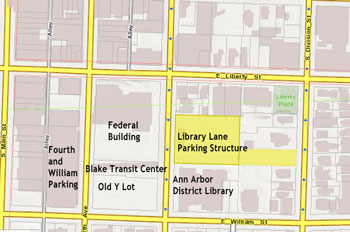
The surface of the Library Lane parking structure is highlighted in yellow. The city council has designated 12,000 square feet of that lot, on the west side along the South Fifth Avenue, as a future park.
During PAC’s April 15 discussion, which lasted about 30 minutes, councilmember Mike Anglin – who serves as an ex officio member of PAC and who supports a Library Lane public space – told commissioners that the council didn’t give direction to PAC, but he thought that PAC should take initiative. PAC should start coming up with ideas about how a park at Library Lane should be designed, he said – who should be involved, how the meetings should be held, and how the process should be handled. He urged commissioners to watch the council’s April 14 deliberations, saying “that’s about the only way to truly understand what happened … because discussions take strange directions.”
It would be a real task to develop the city’s “first urban park,” he said. “The field, to me, is kind of open,” but there is direction to move forward. “There’s all sorts of … language going around and a lot of words being expressed, but there’s still a lot of room for discussion.” Anglin said he was confident that the community is intelligent enough to figure it out, though it might take a long time.
Another factor is that the council directed the city administrator to hire a broker for the possible sale of development rights on a portion of the Library Lane site.
Anglin told commissioners on April 15 that PAC should take the initiative, but there shouldn’t be a “stacked deck” with a pre-determined outcome. “If we do that, the process will die immediately – it’ll be dead on arrival.” A stacked deck is when the process is conducted “with all your cronies,” he said. Instead, it needs to be inclusive, with people that will likely disagree. He said he knew the library, for example, would come with some strong opinions.
David Santacroce, who was appointed to PAC in November 2013, told Anglin that he’d read the recommendation from PAC about downtown parks, and was confused about what’s expected of PAC now. “It seems like a re-do of the same work,” Santacroce said. “I don’t understand what’s supposed to be different about this public engagement and this downtown study that didn’t happen in the last go-around.” Was the council looking for more specifics about what kind of park should go there?
Colin Smith, the city’s parks and recreation manager, said there’s a tendency to “remember what was said last.” Much of the recent discussion had been on the size of a park at Library Lane, and whether the city administrator should retain a broker, he said. But when PAC’s downtown park subcommittee had solicited feedback in 2013, they got over 1,600 survey responses and provided a lot of information, he noted. Smith thought it would be valuable to remind people about that, and to take another look at the public feedback from those surveys. There’s a lot of information about what residents would like to see in a downtown park. “We’ve got a pulse on that,” Smith said. [.pdf of downtown park survey results]
Anglin said he’s always felt that the major stakeholders are the library, the city, and maybe a developer. Some councilmembers think the developer should take care of and pay for a park. There are also “background people” who are privately saying that they would pay for a park, he said. “The game is not over yet.” So in that context, Anglin added, the community needs to have a discussion about “what do you want your town to be like in the downtown?”
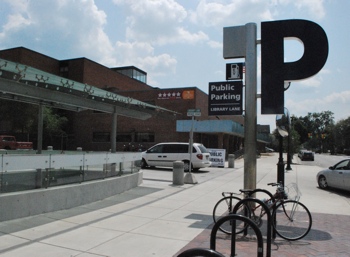
Library Lane is a small two-way street that runs between South Fifth and Division, north of the downtown library – the brick building in the background. The street was built as part of the city-owned underground parking structure.
Anglin indicated that the Ann Arbor District Library might come up with a plan to build a new downtown library, which might include the Library Lane park area. The city made a major investment in that site, he said – maybe more than $56 million. The design of a park might include a couple of fountains, he said, or a band shell, a place to play chess, a rose garden and trees. He said that Argo Cascades “was never in the plan,” but that’s been a success. “If we build something and we’re not pleased with it, it can come out,” he added. The city has land and an opportunity for an urban park next to the library, where more people go than anyplace else in town, he said.
Graydon Krapohl said the question of a vision for the downtown is bigger than PAC’s role. Krapohl agreed that there’s already a lot of good information in the downtown park subcommittee’s report that was provided to council. It’s premature to have PAC develop ideas for a park without knowing what a developer might do or what kind of development might be there, he said. After a developer is involved, then PAC would have a role, he said. But it would be a waste of time and money to work on a design before that.
Krapohl thought that by setting the Library Lane’s park size at 12,000 square feet, it might have eliminated some potential interest in developing the property.
Krapohl also noted that the downtown park subcommittee worked for eight months to develop recommendations, which the full commission approved. He pointed out that Anglin was the only councilmember who didn’t vote to support that report at the council meeting. Anglin hadn’t provided any input or guidance to PAC about how the recommendations should have been shaped, Krapohl said.
Ingrid Ault said she’d been frustrated by the “blatant ignoring” of two key components in those recommendations – the point that funding needs to be identified, and if funding comes from the parks and recreation budget, what’s the impact on other programs? She also thought that council was ignoring placemaking principles that had been identified in the recommendations. “You’re asking us to design some kind of a park in an area that we know, based on best practices, won’t do well,” she said. “For me, that was really quite frustrating.”
Missy Stults agreed with Ault and Krapohl. She suggested returning to the downtown park subcommittee’s survey of residents, and draw out some of the main themes from respondents. But she agreed that PAC’s role right now shouldn’t extend beyond that.
Anglin responded, saying he’s well aware that the city doesn’t protect the citizens’ property “as much as we do the developers’ property.” The Library Lane site is the public’s property, and he wanted that discussion to occur. If it were already a park, then of course PAC would be involved in planning it, he said.
Regarding PAC’s recommendations for downtown parks, Anglin said he objected to the recommendation for development, because the community hadn’t said they wanted development there.
Santacroce then asked whether Anglin wanted additional input on whether there should be any development on the Library Lane site. Anglin indicated that he objected to the assumption that the lot would need to be developed, in order to recoup the city’s investment in the infrastructure there. He said that when the library ultimately builds a new downtown library, “it will be a spectacular work of art, if you will, and a community resource that we can all be proud of – as we are today.”
Anglin said he didn’t have all the answers, but he thought the answers could come from the community. To him, it wasn’t political – he just liked the concept of having a community commons.
Krapohl again said it sounded like a broader discussion that PAC could participate in, but that it wasn’t PAC’s role to lead. That broader question is what do residents want downtown to be. That discussion would in turn provide guidance regarding the Library Lane site. Does the community want part of the site developed so that the city can reap the return of tax revenue for years to come? Or should it be a large park, that will have to be paid for some way?
The broader discussion needs to include businesses, Krapohl said, as well as the DDA, neighborhood associations, PAC, the planning commission, the environmental commission and others.
Santacroce asked whether the council resolution already called for a building on the Library Lane site. If so, then “isn’t this issue out of the barn already?” One of the resolved clauses from the April 7 resolution states:
RESOLVED, That the City will work with the developer of the remaining portion of the Library Lane site to ensure that the designs for both spaces, an urban public park and the adjacent development, complement and support each other’s successful uses;
Anglin replied that developers would have to know what they’re getting, and the council has carved out 12,000 square feet for a park. It might take a long time, he said. Anglin also noted that he and other councilmembers simply want to discuss this issue with the community.
Smith noted that at the April 7 meeting, the council passed a resolution directing the city administrator to hire a broker for possible sale of development rights on the portion of the Library Lane site that’s not designated for a park. He pointed out that a different resolution, which would have stopped this process, was not approved by the council.
Instead of re-inventing the wheel, Smith noted that there was also extensive outreach regarding a vision for downtown as part of the DDA’s Connecting William Street study. There’s a tremendous amount of information in that effort, too, he said. More time needs to be spent evaluating the existing information that’s already available.
Smith noted that some people in the community would rather not see any private development on the Library Lane site. There are others who view this as an opportunity for collaboration and compatibility between the private and public sectors, he said. Smith pointed to results from the downtown park subcommittee survey, in which about 70% of the 1,600 respondents preferred a public/private approach to funding. Those responses shouldn’t be forgotten, he said.
Liberty Plaza and Library Lane: July 15 Public Commentary
At PAC’s July 15 meeting, two people spoke during public commentary to address the issue of a park at the Library Lane site.
Gwen Nystuen, a former park commissioner, said she was there to talk about the Library Lane site. In June, the city council had asked PAC to develop a conceptual design integrating Liberty Plaza and Library Green – or whatever it will be called, she said. The intent was that the two parks should complement each other and become successful urban design parks. It will be challenging, but worth it, Nystuen said. There’s no question that Ann Arbor needs public open space downtown, and it has the ability to make the parks exciting and attractive, she said.

Former PAC member Gwen Nystuen and Ward 5 city councilmember Mike Anglin, who serves as an ex officio member of PAC.
Nystuen showed two drawings by the Library Green Conservancy, illustrating how walkways could be developed. The drawings were taken from a 1991 Luckenbach/Ziegelman report that looked at development of the entire block. [.pdf of Luckenbach/Ziegelman report] Nystuen pointed out that there are park acquisition funds that could be used to buy easements to make these paths possible.
She noted that there are several properties in that block that might be redeveloped, including the downtown library and credit union site. That means it’s important to plan for the pedestrian connections, she said. The downtown citizens advisory council has supported creating pathways to walk through the block from as many directions as possible. PAC’s own recommendations, she noted, state that “Future improvements should also work to create a permanent and highly visible connection between Library Lot and Liberty Plaza.”
Eric Lipson introduced himself as a 35-year resident of Ann Arbor and former city planning commissioner. He’s also a member of the Library Green Conservancy, which has been advocating for a public park atop the Library Lane underground parking structure. And he’s a member of the Rotary Club of Ann Arbor, which is helping to fund a universal access playground at Gallup Park. He’s happy and excited that PAC is looking at ways to design and improve Liberty Plaza. But it makes obvious sense to plan not just for Liberty Plaza, but also for the entire block – bounded by Fifth and Division, and William and Liberty. There are some areas with barriers to pedestrian flow at Liberty Plaza, such as steps, which discourage the plaza’s use by the general public and encourage use “by those seeking to take advantage of the privacy of the sunken cul-de-sacs,” he said.
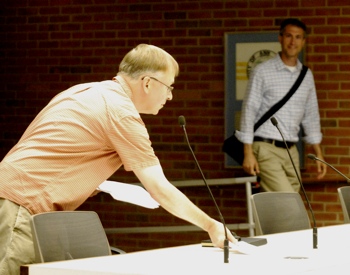
Will Hathaway of the Library Green Conservancy passes out materials before PAC’s July 15 meeting. In the background is Christopher Taylor, a city councilmember and ex officio member of PAC.
Effective approaches to planning of public open space look at ways to connect activity centers, like the Diag does. The vision of connected public spaces on the Library Lot has been endorsed many times, Lipson noted – by the 1991 Luckenbach/Ziegelman study, the 2005 Calthorpe, the survey done by the Ann Arbor Downtown Development Authority for its Connecting William Street project, and PAC’s own survey of public preferences for downtown parks. Lipson noted that last spring, mayor John Hieftje proposed a clearly defined pedestrian path that would connect Liberty Plaza with public open space on the Library Lot, and then continue on to the former Y lot and the city-owned lot at the corner of Main and William, next to Palio restaurant. “This makes all the sense in the world,” Lipson said.
Liberty Plaza is the logical collection point and gateway from Liberty Street to the library, credit union, bus station, and on to Main Street. Bringing walkways from Division and Liberty up to grade, along with improved lighting and signage, would go a long way to creating a constant pedestrian flow, improve handicapped access and deter illicit behavior, he said. Preserving mature trees will make their shade a welcome place to gather on hot days. A water feature would be wonderful – perhaps using water currently collected and stored under the Library Lane lot.
Connecting Liberty Plaza to the proposed Library Lot plaza will create numerous opportunities for activating both corners of that block and all of the “activity-generators” between and beyond that area. It’s an exciting opportunity for PAC to have a major impact on the vitality of the downtown, Lipson concluded. He hoped commissioners would take full advantage of it.
Liberty Plaza: Commission Discussion
When PAC reached the two Liberty Plaza items on its July 15 agenda – the fee waiver and the city council’s referral of the resolution on Liberty Plaza – chair Ingrid Ault suggested that the conversation should be postponed. She said that key PAC members were absent, who could offer insight: Bob Galardi, Alan Jackson, Graydon Krapohl.
Ault noted that Galardi is chair of the Allen Creek Greenway Conservancy board. She pointed out that Krapohl is PAC’s vice chair and had participated in the downtown park subcommittee, though he wasn’t an official subcommittee member. And Jackson had been instrumental in that subcommittee’s work, she said. Ault thought it would be prudent to wait until those members were at the table, before having this discussion.
No one objected.
Ault asked PAC’s city council representatives – Christopher Taylor and Mike Anglin – whether this would be an issue for the council. Both Taylor and Anglin indicated that it would not be a problem to wait.
There was no discussion of the specific meeting at which these issues would be re-introduced. The previous fee waiver for Liberty Plaza expired on July 1, 2014.
By way of additional background, the next scheduled meeting for PAC, on Aug. 19, will fall two weeks after the Aug. 5 primary election. Graydon Krapohl, PAC’s vice chair, is the only candidate running for Ward 4 city council. Christopher Taylor is one of four Democrats running for mayor.
In addition, PAC chair Ingrid Ault is expected to resign her post later this year, as she is moving out of town. Earlier this year she took a job as an educator with the Michigan State University Extension in Calhoun County, Michigan, based in Marshall. She has been commuting there from her residence in Ann Arbor.
Outcome: This was not a voting item.
Fuller Park
A resolution to recommend the possible four-year extension on a University of Michigan lease of three parking lots at Fuller Park appeared on PAC’s July 15 agenda.
The existing lease expires on Aug. 31, 2014. The three lots are: (1) the parking lot south of Fuller Road, next to the railroad tracks (Lot A); (2) the paved parking lot north of Fuller Road at Fuller Park (Lot B); and (3) the unpaved parking lot north of Fuller Road at Fuller Park (Lot C). The lots are used by UM during restricted hours.
The city has leased Lot A to UM since 1993. Lots B and C have been leased since 2009.
The proposal, which requires city council approval, is for a two-year lease with one additional two-year option for renewal. Annual revenue of this lease will be $78,665, and will be included as part of the parks and recreation general fund budget. [.pdf of proposed lease agreement] [.pdf of staff report]
The hours that UM can use these lots are stipulated in the agreement:
- Lot A: 4 a.m. to 4 p.m. Monday through Friday.
- Lot B (paved lot): 6 a.m. to 5 p.m. Monday through Friday, beginning the day after Labor Day through the Friday before Memorial Day, excluding holidays.
- Lot C (unpaved lot): 6 a.m. to 5 p.m. Monday through Friday, excluding holidays.
Colin Smith, parks and recreation manager, noted that the revenue from these three lots is significant for the parks and recreation operating budget. The current agreement – which was approved by the council in 2009 and extended by two administrative renewals – is essentially the same as the agreement that will expire, Smith said.
The main purpose of the lots is for the parks, Smith explained. That’s reflected in the hours during which UM can use the lots – on weekdays, prior to 4-5 p.m. The outdoor pool and soccer fields don’t need the quantity of parking during the winter or off-season. “It’s an asset within the parks department that we can either have sit there, or we can lease it for a significant amount of revenue that obviously helps us provide other programs,” he said. If the city doesn’t lease those parking lots, “I am absolutely certain that people will park in it anyway,” Smith added.
Fuller Park: Public Commentary
Three people spoke during public commentary about Fuller Park.
Nancy Shiffler introduced herself as chair of the Huron Valley Group of the Sierra Club. She was there to talk about Fuller Park and the potential location of a new train station. In looking at the lease agreement, there seems to be an assumption that the train station could go on the south side of Fuller Road, on a portion of Fuller Park. The city is going through an environmental review of potential sites, and the Sierra Club is concerned that the appropriate procedures are followed, she said. In particular, that means taking into account the Dept. of Transportation’s Section 4(F) requirements when one of the proposed sites involves city parkland. There’s a hope that PAC would be looking closely at the criteria that are being used to evaluate sites in that review process, she said.
When it comes to Fuller Park, the assessment should be looking at the impact on the park in its entirety, Shiffler stressed, not simply the portion of the site where a station might be located. If you look at projections of 10 Amtrak runs per day, plus an unknown number of commuter passengers – which could reach up to 500,000 a year – then the traffic impact along the Fuller Road corridor would be increased a lot, she said. It should be very clear what the impact might be on Fuller Pool and the rest of the park, such as the impact on air quality from idling trains and buses. She noted that a station could impact the Border-to-Border trail, which is intended to run through a portion of the park, as well as the entire Huron River valley.
Rita Mitchell said she’d been following the issues related to Fuller Park for a long time – since 2009, when there was proposal to build a large parking structure there. There’s been a parking lot of the site for more than 20 years, “but it was a park beforehand,” she noted, and it was one of the earliest parks in Ann Arbor along the river. It has history that some people haven’t seen, because they’re newcomers to Ann Arbor.
Mitchell said that part of Fuller Park could be returned a recreation area, or a place that could mirror the kinds of things that happen now in Gallup Park, which is often very crowded. As someone who’s a member of Protect Ann Arbor Parks, Mitchell asked PAC to consider the issues of protecting parkland, and to avoid the potential of turning it into a transportation center. If it could happen there, what would stop it from happening in any park?
Mitchell said it was disturbing to see an early termination clause in the lease agreement with UM. She hoped that PAC would study it carefully, possibly put it on the table for a while, and acknowledge that the public has not weighed in on a transportation center at that location. The environmental assessment for a train station is still going on, she noted, so it’s disturbing to see a transportation center referenced in a document that would be signed by the city.
George Gaston noted that he lived by Island Park, one of the oldest parks in the city. He came to speak in defense of Fuller Park, one of the chain of parks along the river assembled by Eli Gallup during his 38-year term as parks superintendent for the city. When Gallup assembled these properties, Gaston said, there were houses, farms, businesses and factories – it was not open, vacant land. There was a conscious effort to open up the riverside for public use, and “we would like to see it maintained for public use,” he said. The surface parking lot at Fuller Park (Lot A) was never intended to be permanent, Gaston said. At the time when the lease was first signed, PAC had considered it a temporary measure to provide parking as part of a swap while the UM Cancer Center was being built. Twenty years later, it’s still there.
If the city is intent on renewing this lease, Gaston said, he asked whether PAC has reviewed the figures involved. There’s another parking lot at Riverside Park that the university leases from the city, and there’s a great disparity between what UM pays there compared to the Fuller Park lot, he said. The city needs to decide whether it should be subsidizing parking for the university or should the city be getting full value from the lease. The university charges its departments as well as individuals for the parking permits, he noted. It’s still parkland, would be nice to be used for the Border-to-Border trail. There isn’t enough parking for the parks now, Gaston concluded.
Fuller Park: Commission Discussion
Colin Smith, manager of parks and recreation, responded to some of the issues raised during public commentary. He said that he and other staff are very concerned about making sure that whatever happens with the train station is done in an open and transparent way. That’s why Eli Cooper, the city’s transportation program manager, and the consultant on this project addressed PAC earlier this year to give an update, Smith said. He and park planner Amy Kuras are involved in that process, to evaluate the potential sites for a station. That work is ongoing, and any recommendations will be brought to PAC for review.
Smith pointed out that the PAC meeting packet had included both a proposed new lease as well as a copy of the 2012 lease agreement. [.pdf of proposed 2014 lease] [.pdf of 2012 lease]
Smith noted that the 2012 lease, which was the same one that had been in place since 2009, had a section on page 3 that was titled “Early Termination/Potential Rail Station and Local Connector.” It specifically addressed the project that was called the Fuller Road Station.
The reality, Smith said, is that this agreement isn’t about the train station. It’s a lease agreement between two parties for the use of a parking lot, while recognizing what’s going on in the community, he added. “It is possible, if the public decides and council decides, that this could become something else. And as such, it seems both kind of a courtesy and a standard business practice to let the people who you’re going into a lease with know that there may be a change,” he said, and to clarify how it would be addressed.
So this is nothing new, Smith concluded. The change between the 2014 lease and the prior lease is the title of that section, which is now titled “Early Termination/Transportation Use.” That section states:
City reserves the right to terminate this Lease for use of all or a portion of the site to facilitate public transportation with 12 months advance written notification to University. Termination under this provision will be automatically effective on the date specified in the notice and City shall have no further obligation to University under this Lease except that if the 12-month notice period occurs so as to cross annual payment periods (i.e. for example: notice period June- May/annual payment period September-August), University shall be entitled to a rebate of that portion of the annual payment applicable to the months after the termination date.
Upon initiating formal planning for construction of a new commuter rail station, relocating the Ann Arbor Amtrak intercity passenger station or developing a local connector service contemplating use of a part, or all, of Lot A, City shall notify University of such planning considerations. Notification shall be in writing and will include information regarding University input in City’s planning process. City will work cooperatively with University while considering enhancing transportation service to this location. The planning process will assure both parties’ interests are included in all considerations. It is recognized that provision of high capacity public mass transportation service to this site is intended to increase access and mobility resulting in a decrease in the need for surface parking by University. Notwithstanding the above, it is understood by the parties that participation by University in the planning process does not negate or otherwise impact City’s right to terminate this Lease for the reason stated.
Karen Levin asked why there needs to be any mention of “transportation use.” Why can’t the lease simply mention the early termination option? “It seems like that’s what there’s a concern about,” she said. Why is there a need to be so specific? Early termination could result from something else, she noted.
Smith replied that the section is included as a recognition of what’s going on in the community, a conversation that’s essentially running parallel with the lease and that includes the same property.
Levin was concerned that the section makes it appear that PAC is indirectly endorsing a train station at that location.
David Santacroce said that if he were in the university’s position, he wouldn’t want to sign a lease “where you could willy-nilly cancel it for any reason.” So having a specific reason gives the university some comfort in the negotiation process, he said.
Smith noted that the section prior to that includes standard default/termination language, allowing either party to terminate under certain conditions.
The section titled “Early Termination/Transportation Use” in the 2014 proposed lease is actually somewhat shorter and less specific than the 2012 version, he noted.
Missy Stults told Smith that she picked up from public commentary the sense that the use of Fuller Park land as a parking lot was intended to be temporary. She asked him to talk about that history, and whether there’s been any discussion about reverting it to parkland.
Smith replied that the lot on the south side of Fuller Road, Lot A, has been a parking lot leased to the university for 21 years. The other lots have been leased since 2009. In terms of needs for additional parkland space at that location, “it’s not something I’ve had a strong call for,” he said. It wasn’t clear how all of the space would be used for the Border-to-Border trail, for example. During the summer months in the evenings, most of the parking is used for park activities – including the pool and soccer fields. So “I would certainly be hesitant to remove parking for park use,” Smith said.
Levin again expressed concern about the language in the agreement. She thought the lease made it appear that the train station would be located there, and she hoped there was a way to indicate that it was only a possibility.
Smith noted that the language has been in the lease for about six years, and it hasn’t caused a “great deal of heartache.” But if it would make commissioners feel more comfortable, he said, he could contact the university and see if it’s important that the language remain. If it’s removed, he added, he didn’t think it changed things very much. The environmental assessment for a train station’s potential new location will continue, he noted. The lease “doesn’t have the strength to determine that this is the site for a station. This doesn’t do that at all.”
Christopher Taylor weighed in, saying that “the obligations that the language creates are predicated upon, or rather spring from when the thing occurs.” As a consequence, the agreement has to talk about the thing occurring, he said, in order to describe what happens after it occurs. Taylor said it’s like the heading could be “If A Large Number of Things Fall Into Place Such That A Station Is Proposed And Planned At This Location,” then the following things would happen. He said the lease lists what would need to happen if all those things occur, but “it doesn’t push it, I don’t think.” It doesn’t predispose the city or university to do certain things, Taylor continued, “it’s just a contingency.”
Mike Anglin asked whether commissioners would be amenable to stating that the passage of this recommendation in no way supports a decision to move forward with the train station. It would indicate that this isn’t an endorsement of a train station location, he said, but simply addressing the needs that the park system has for this revenue. PAC is not endorsing any railroad station in parkland, he said – “period.” Nor is PAC not endorsing, he noted.
Santacroce said he didn’t read the lease as an endorsement. But at some point, PAC might decide that it does want to endorse a train station at that location. To include language stating that it’s not an endorsement or a refusal to endorse “all feels to me a little bit wrought.” The proposed agreement struck him as just good planning for the future. He understood the concerns, but thought that the debate over the train station “is a whole different subject, and this doesn’t speak to it at all – other than giving the city an option, at some point.”
Anglin pointed out that the lease requires council approval. He urged that some caveat be included, in order to secure that approval.
Stults clarified with Smith that the city attorney’s office had already reviewed the lease. She wondered if adding the word “if” would provide some assurance, inserted into this sentence: “If upon initiating formal planning for construction of a new commuter rail station …” She asked the two attorneys who serve on PAC – Santacroce and Taylor – what they thought.
Santacroce indicated that it was awkward, because “clearly some legal minds already thought about the construction of this,” and he was hesitant to change it.
Taylor said he already read the language as constituting a “condition precedent upon initiating formal planning when that thing occurs.” He added: “That thing is not going to occur without a large, full, transparent conversation – if ever.” If he were drafting the lease, he would have no problem inserting “if” into the agreement. However, “I don’t know that it’s our role to wordsmith it,” he added.
Taylor indicated that if PAC passed the recommendation, it would be important for him and Anglin to communicate to the council that the recommendation “is entirely silent as to whether or not a station at this location is wise or foolish.”
Smith pointed out that the “if” is implied in the first paragraph of that section: “City reserves the right to terminate this Lease for use of all or a portion of the site to facilitate public transportation with 12 months advance written notification to University.” He also described the kind of input that he and Kuras were providing for the environmental assessment, noting that they’ll continue to be involved in that effort.
Santacroce noted that PAC is being asked to do is to recommend that the city sign the lease. Ultimately, the council will decide. And as long as it’s communicated clearly that PAC isn’t taking a position on the use of the park for a train station, he was comfortable with this resolution.
Anglin then pointed out that all parkland is considered public land, and “subject to transportation use.”
Levin again suggested adding something to the resolution to address the concern that had been raised during public commentary. Smith said he understood her position, but he wondered whether it would be “cleaner” for councilmembers to simply share PAC’s conversation about this issue with the rest of council – rather than adding a resolved clause that doesn’t have anything to do with the business at hand. He noted that it wouldn’t be an issue if the current agreement didn’t expire until next year. The expiration just happened to coincide with the environmental assessment for a train station location.
Stults wondered if PAC ever communicated to council by attaching a memo or cover letter with its resolution. Smith replied: “You may do whatever you want when it comes to communicating with council.” He thought council would welcome feedback on this, with the resolution or additional communication.
Santacroce suggested adding a resolved clause: “Whereas by this resolution, PAC takes no position on any potential use of this land at this time.” This is about appearances, he said, and although he doesn’t read it that way, some people could interpret the termination language as a threat. He’s hesitant to change the lease itself, because of the logistics involved – it would have to go back to the city attorney’s office and the UM general counsel’s office. “They’ll be spending money, we’ll be spending money – it just seems like a waste of effort that could go elsewhere.”
Anglin characterized it as a controversial issue. If he were drafting the lease, he’d strike all language out of the agreement that mentioned the possible transportation or any future use. There’s been a community conversation and it’s down to two sites, he said, “so it’s getting near decision time.” He didn’t think PAC’s job was to reflect “on what is going on out there. It’s not affecting this lease in any shape or form – unless there’s some legal things going on” regarding land use or other constraints. He thought the dialogue would still be going on for at least two more years.
Anglin said the city had a lot of other parking agreements with UM, and those don’t mention anything like this. “Rather than confuse it and muddy some waters in pro or con, it’s best to just pull back and say we’re just leasing it,” he said. It was just a suggestion, he added, but he thought there would be some councilmembers who’d share that opinion.
Smith replied that you could see it both ways. One could argue that it’s more transparent to mention the possible transportation use as part of the lease agreement, he said, compared to leaving it out. “It’s obviously perceived otherwise by some, too,” he added.
Santacroce thought it made simple business sense to leave the section in the lease, even if the possibility of putting a transportation center there is remote. He didn’t want to get involved in a discussion about whether it should be located there, but it would be foolhardy for the city not to include that option.
Taylor then proposed adding a whereas clause to the resolution: “Whereas this resolution does not commit PAC to support or reject the use of Lot A as a rail station.”
Other commissioners indicated support for adding that clause to their resolution.
As the discussion wrapped up, Smith also responded to another concern raised during public commentary – about the amount being charged for the Fuller Park lots, compared to parking at Riverside Park. At Riverside, a handful of spaces are leased to the university off of Canal Street. Those spots do bring in more per spot, he noted. The university rents those spots as “Blue” parking permits. The spots at Fuller Park are “Yellow” permits. The university issues those Yellow permits for $153 per year. There are roughly 450 spots at Fuller, but the university doesn’t have access to those lots at all times, he noted. [.pdf of UM parking permit fees]
Outcome: PAC unanimously recommended approval of the lease renewal. The recommendation will be forwarded to the city council for consideration.
Mack Pool
Gayle Hurn, recreation supervisor for Mack and Fuller pools, made a presentation to PAC about the past season at Mack indoor pool, and a look ahead at things to come. [.pdf of Hurn's presentation]
By way of background, in April 2009 former city administrator Roger Fraser had proposed either closing Mack Pool or turning it over to the Ann Arbor Public Schools, as a way to help balance the city’s budget in the face of declining revenues. Supporters of the pool mobilized to come up with ideas for cutting expenses and increasing pool revenues. Ultimately, the city council voted for a budget that included keeping the pool. For additional background, see Chronicle coverage: “Task Force Floats Ways to Save Mack Pool“; “More Options for Ann Arbor’s Mack Pool“; and “Ann Arbor Budget: Formal Commencement.”
At PAC’s July 15 meeting, Hurn began by describing the features of the pool, which is located inside the AAPS school Ann Arbor Open. The pool is shared, and used by the school in the morning and by the public in the very early mornings, afternoons, evenings and weekends.
It’s the city’s only indoor pool – a six-lane, 25 yard pool with an attached 30-foot by 45-foot toddler area. It employs 15-18 seasonal workers. Last season, there were over 67,000 visits to the pool.
In the 2013-2014 fiscal year, the pool was budgeted for revenue of $119,000 but brought in more than that – $159,000. That was due to new programming and different ways of using the pool space and time, Hurn said. The new program also resulted in higher-than-budgeted expenses, she noted – about $29,000 over budget. Now that the new programs have been started, the intent is to help those grow to increase the revenue while keeping expenses stable.
The staff is trying to create as many new opportunities for using the pool as possible, Hurn explained. Having more people exposed to swimming means the community is healthier, and that there’s support for keeping Mack Pool open.
Programs include:
- Group swim lessons, with 299 participants in 2013-14 compared to 246 the previous year. The staff is looking at offering more classes at different skill levels.
- Private, one-on-one swim lessons, with 237 participants in 2013-14 compared to 110 a year ago.
- Masters swim sessions, with 384 registered pass holders and 383 drop-in swimmers. The previous year, there were 283 pass holders.
- A youth swim team – the Mack Manta Rays – was a new addition in the 2013-14 season, and was very successful, Hurn said. There were 183 registered swimmers over two sessions. They compete against teams in Chelsea, Dexter, Ypsilanti and other municipalities.
- Water aerobics had 63 participants, and is another program that the staff hopes to grow.
- Log rolling was new in the 2013-14 season, and was a huge hit, Hurn said. An initial demonstration by representatives of Keylog Rolling resulted in Hurn buying one of the logs and using it for special events, for workshops and private parties. Hurn hopes to someday form a competitive team.
In addition to these programs, Mack Pool also offers special events, including monthly “Splash Days” and four “Dive-In” movie nights, when families can bring their flotation devices to watch a children’s film. The most popular one was “Frozen,” Hurn said. It’s something that’s being carried over to the city’s outdoor pools as well.
Hurn also described training that’s provided to pool staff, including re-certification courses for CPR and lifeguarding. They also offer Red Cross lifeguard certification courses to the public now, too.
Regarding maintenance, Hurn reported that a large roof repair project is being completed this summer. A new pool cover was purchased to help reducing heating costs. That made a big difference, she said, especially coupled with thermal curtains that were hung during the winter. The pool pump was also rebuilt.
Looking ahead, Hurn described efforts to grow the use of Mack Pool, including more evening group swim lessons, more private lessons, and a wider variety of party packages
Mack Pool: Commission Discussion
Paige Morrison asked about the expansion of private parties, and wondered how many hours per week the pool would be available for that.
Gayle Hurn said that most people are looking to book parties on the weekends. The pool closes to the public at 6 p.m., so a private dive-in movie party could be scheduled after that. She noted that private birthday parties are also booked during the pool’s general swim time on Saturdays, and use only a portion of the pool.
Ingrid Ault thanked Hurn for her work and enthusiasm, and pledged to learn how to log roll.
Colin Smith, the city’s parks and recreation manager, praised Hurn for her work. It’s her first year in that position, and has brought energy and enthusiasm as reflected in new programming. Smith also complimented deputy parks & recreation manager Jeff Straw, who supervises Hurn. Smith noted that Straw gives the staff latitude to try new ideas, even ones that seem a little “out there.”
Manager’s Report
Colin Smith, the city’s parks and recreation manager, provided several updates. He noted that the city’s fiscal year ended on June 30, 2014. Typically a detailed year-end financial report would be provided at the July meeting, but Bob Galardi – chair of PAC’s budget and finance committee – couldn’t attend the July 15 meeting.
As a quick preview, Smith said, the parks and recreation unit exceeded its revenue budget for the year. The budget had called for $3.729 million in revenues, but actual revenues were about $3.81 million for the year. Revenues were up for the canoe liveries and Mack Pool.
The expenditure budget was $5.273 million, and actual expenditures were slightly lower – $5.186 million. He noted that more bills for the year will be arriving, so the final amount for expenditures could be higher. A more detailed update will be presented to PAC at its August meeting.
Smith also reported that the first meeting had been held for a subcommittee to discuss smoking in the parks. He thought the group would have something to report to PAC in August.
Responding to a query from Ingrid Ault, Smith said that on the weekends, University of Michigan is allowing the city to use its surface parking near the Kellogg Eye Center, near Argo Pond. There’ve been 80-100 cars parked there each weekend day. A shuttle comes by to take people to the canoe livery, or it’s within walking distance, he said. The arrangement has reduced complaints about parking in the neighborhood near Argo Pond. UM is not charging the city for the parking use, he said.
Present: Ingrid Ault, Karen Levin, Paige Morrison, David Santacroce, Missy Stults, and councilmembers Mike Anglin and Christopher Taylor (ex-officio members). Also Colin Smith, city parks and recreation manager.
Absent: Bob Galardi, Alan Jackson, Graydon Krapohl.
Next PAC meeting: Tuesday, Aug. 19, 2014 at 4 p.m. in the city hall second-floor council chambers, 301 E. Huron St., Ann Arbor. [Check Chronicle event listing to confirm date]
The Chronicle survives in part through regular voluntary subscriptions to support our coverage of public bodies like the Ann Arbor park advisory commission. If you’re already helping The Chronicle with some financial green, please encourage your friends, neighbors and coworkers to do the same. Click this link for details: Subscribe to The Chronicle.




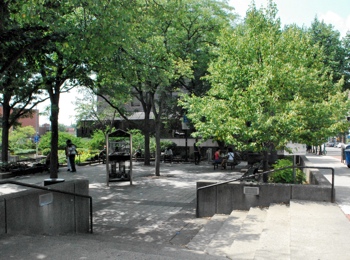
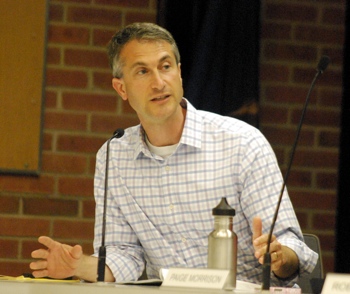
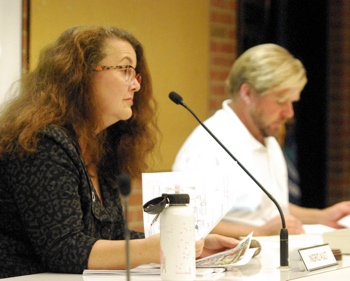
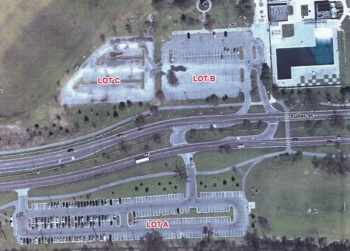
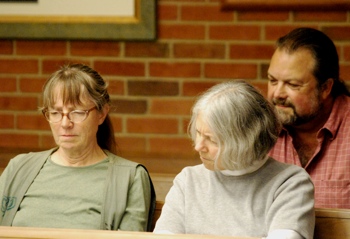
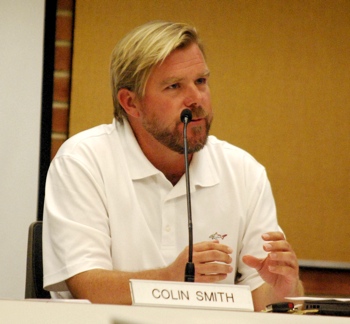

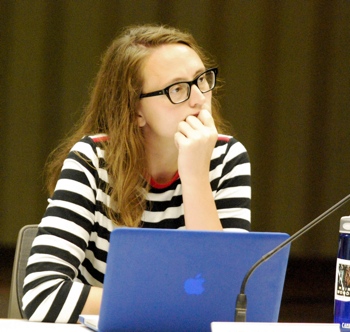

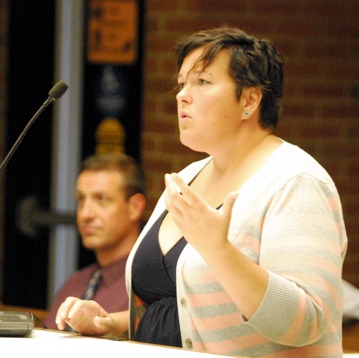
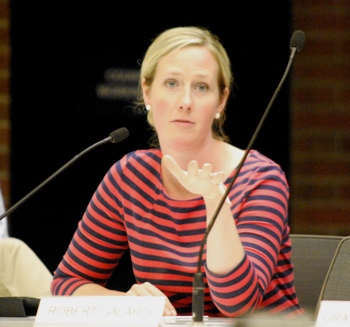
The discussion about the future of Liberty Plaza and the Library Lane/Library Lot which began at City Council has now bounced back to the Parks Advisory Commission. When PAC Chair Ingrid Ault expresses frustration, I can empathize – although not for the same reasons she cites.
Earlier this year, the Library Green Conservancy worked with supportive members of City Council to draft resolution that closely followed the 2013 recommendations from the PAC subcommittee on downtown parks and open spaces. That resolution even spelled out a role for PAC going forward. However, when I spoke at the PAC meeting on February 25 (before City Council considered the resolution), several PAC members raised concerns that there needed to be more process before making any decisions. Parks Department staff voiced concern that there was too much specific direction for next steps. The overall message was that PAC and Park Department staff would prefer more autonomy in deciding what next steps to take with regard to design elements for the park/plaza.
As a result of PAC’s concerns and similar issues raised by some members of City Council, the resolution was modified. The specific references to PAC and Parks Department leadership of next steps were removed. Ironically, after City Council’s March 17 vote, PAC commissioners expressed confusion. PAC now saw no role for itself in addressing the many remaining questions about the park’s design. A professed stumbling block was the degree of uncertainty. On April 7, City Council addressed one aspect of the uncertainty by designating a more precise figure for the park/plaza square footage at 12,000 square feet.
It should be noted that the PAC’s recommendations are not completely accurate. For example, we’ve learned that the 5,000 square foot civic plaza that PAC cited from the DDA’s Connecting William Street report is too small. The figure was adjusted upward after PAC’s report to 6,500 sf by City staff, but even that figure is too small. In a recent conversation with U-M Urban Planning Professor Doug Kelbaugh, we learned that the portion of Fifth Avenue frontage that is designed for a civic plaza (i.e. it lacks the reinforced footings to support construction above) is actually close to 8,000 square feet. City Council added a mere 4,000 square feet when it designated the full Fifth Avenue frontage for a public park.
Regardless, it appears that City Council’s clarification about the size of the future public open space has not helped matters from the PAC’s point of view. PAC now seems to have adopted a passive role in guiding the park/plaza design, awaiting a proposal from a developer rather than helping to involve the community, including library clients and leaders, in the community dialogue that PAC itself recommended last fall. The argument is based on the uncertainty about what the yet-to-be-identified developer may do with the adjacent part of the City-owned Library Lane site.
The new irony is that a planning study that looks only at Liberty Plaza is being advocated by some of the same people who caution against thinking ahead about the public space on the Library Lane site. The immediately adjacent properties in this instance are the Michigan Square Building and a surface parking lot owned by First Martin Corporation. There is a likelihood that these properties will be redeveloped in the near future, indeed, it could be helpful to the revitalization of Liberty Plaza if First Martin were to make physical changes to these spaces. Who knows, maybe First Martin will build an “iconic,” revenue generating building on private land?
Somehow the same arguments don’t apply in what appear to be similar situations. Proponents of planning for redesign of Liberty Plaza are now willing to cast aside their prior concerns about envisioning public open space adjacent to uncertain future development. In their view, while the “sky will fall” if we were to move forward with thinking about public open space on Library Lane/Library Lot, it is perfectly fine to do the same thing on the other side of the block.
The supposed “best practices” principle to which PAC Chair Ault refers is the debatable “rule” that a public open space will only succeed if it is surrounded on three sides – embedded in a commercial development. Again, the example on the other other side of the Library Block calls this belief into question. An adjacent structure can help to generate activity in a public space as long as it has appropriate tenants. When the Community News and the Pantree Restaurant were tenants in the building next to Liberty Plaza, then there was more variety among those using the park. Now that all the adjacent tenants are offices, the activation has ceased. Wrapping a park in new construction is no guarantee because the uses of that building change – tenants come and go. Activation of public open space is a more complex question.
Regardless of the outcome of the primary election today, I hope that we can begin to work together toward a unified plan for inter-connected, public open space on the Library Block. This would be consistent with the PAC’s 2013 recommendations as well as prior efforts such as the 1991 Luckenbach/Ziegelman report and the the 2005 Calthorpe report.
We know that there will be development/redevelopment that results in new construction on the Library Block and the public spaces should be integrated with these new buildings. The way to move this vision forward isn’t by insisting that each site be treated in isolation – it is only by looking at the block as whole and thinking about how to make it attractive to pedestrians that we’ll really activate all the public spaces.